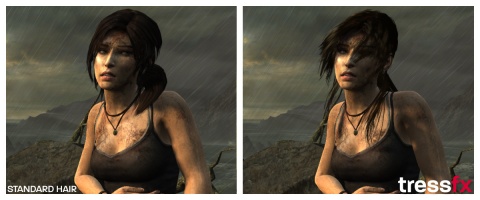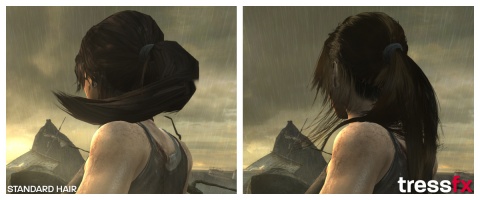AMD Announces TressFX Hair Technology – Real-Time Hair Rendering
AMD today announced TressFX Hair technology, which is the first real-time hair rendering technology to be used in DX11 game titles. The real-time physics calculation accounts for both moisture and wind and will be used in the 2013 release of Tomb Raider. Below you’ll find some images with and without TressFX on Lara Croft’s lovely locks and AMD’s comments on TressFX.

Since the dawn of the 3D era, characters in your favorite games have largely featured totally unrealistic hair: blocky and jagged, often without animation that matches your character’s movements. Many games have attempted to disguise the problem with short haircuts, updos, or even unremovable helmets. But why? Simply: realistic hair is one of the most complex and challenging materials to accurately reproduce in real-time. Convincingly recreating a head of lively hair involves drawing tens of thousands of tiny and individual semi-transparent strands, each of which casts complex shadows and requires anti-aliasing. Even more challengingly, these calculations must be updated dozens of times per second to synchronize with the motion of a character.
Lara Croft is an iconic character with an equally iconic ponytail. Re-imagining Lara (and her haircut) for the 2013 release of Tomb Raider wasn’t just an opportunity to modernize the character, it was an opportunity to substantially advance in-game realism by tackling the long-standing challenge of unrealistic hair. Through painstaking collaboration between software developers at AMD and Crystal Dynamics, Tomb Raider proudly features the world’s first real-time hair rendering technology in a playable game: TressFX Hair.
TressFX Hair revolutionizes Lara Croft’s locks by using the DirectCompute programming language to unlock the massively-parallel processing capabilities of the Graphics Core Next architecture, enabling image quality previously restricted to pre-rendered images. Building on AMD’s previous work on Order Independent Transparency (OIT), this method makes use of Per-Pixel Linked-List (PPLL) data structures to manage rendering complexity and memory usage.


Comments are closed.